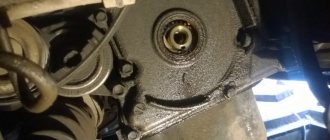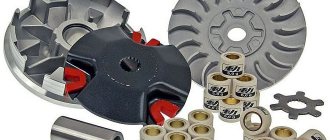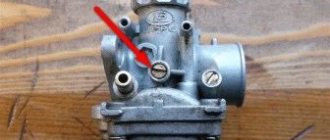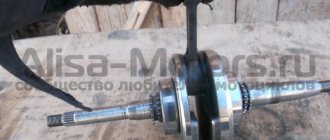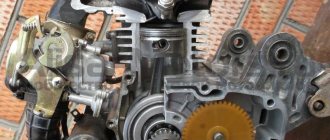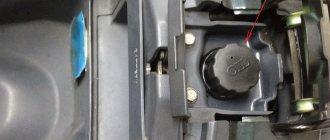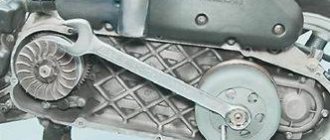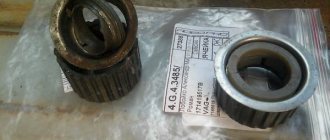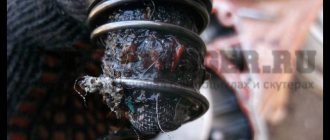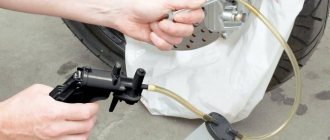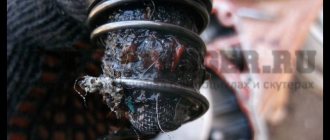Let's repair together: Replacing the crankshaft oil seal on a 2T snowmobile Taiga 500/550/551/250
One of the common problems of a two-stroke engine is air leaks through the crankshaft seals.
As a result of a lean mixture, an increase in operating temperature leads to burnout of the pistons. One of the diagnostic methods is the use of engine temperature sensors, and as soon as you observe an increase in temperature, it’s time to think about diagnosing the snowmobile at a service center.
In the service center, the most common method is to test the engine for crankcase leaks, and if such leaks are detected, disassembly and reassembly are carried out with the elimination of defective parts.
Video instructions for replacing the crankshaft oil seal using the example of the RM Taiga 550:
Engine removal and installation
ATTENTION
Before disconnecting any electrical wire in the starter system, always disconnect the BLACK negative battery cable first (on electric start models).
Disconnect or remove the following:
negative cable from battery (on models with electric start)
centrifugal regulator, using the appropriate puller, according to section 05-03 "Centrifugal regulator"
intake muffler and carburetor(s)
impulse line (air line) from the engine crankcase to the fuel pump
oil supply line from the oil tank to the oil pump (for engines with separate lubrication)
exhaust silencer and muffler cooling sleeve
tie the recoil starter cord into a knot and remove the starter handle
Top of the engine
Cleaning
Remove all seals. Use a seal removal tool and a cleaning agent for the mating surfaces.
Wash (clean) all metal parts in non-ferrous metal cleaner. Scrape off carbon deposits from the cylinder exhaust port, cylinder head and piston crown using a wooden spatula.
NOTE: The arrow on the piston crown should be visible after cleaning.
Clean the piston ring grooves with a piece of the defective ring.
Disassembly
Remove the upper motor casing, air intake couplings, lower casings and fan housing.
Remove the cylinder heads.
Place a rubber pad over the crankcase to keep the lock rings 24 from getting into the crankcase. Then, using a pointed tool inserted into the piston serration, remove the lock ring from the piston 26.
To remove piston pin 25, use a piston pin puller. Perform the operation in the following order:
screw in the puller handle completely
insert the end of the puller into the piston pin
screw the extraction nut (left-hand thread)
Hold the puller firmly and rotate the puller handle counterclockwise to remove the piston pin.
NOTE: The left CVT side cylinder and fan housing must be removed to allow access to the right magdino side cylinder piston pin for a puller.
NOTE: If necessary, piston and rings of repair sizes 0.25 and 0.5 mm fuller can be used.
Control
Refer to Section 04-03, Checking Engine Dimensions, for assistance.
Assembly
To center the piston pin with the connecting rod bearing, use a special centering tool.
NOTE: The piston pin retaining ring on the opposite side of the piston may be installed before the pin is installed and the tool should be able to retract easily.
To reduce the effect of alternating forces on the retaining ring, install each ring so that its connector is in the position shown in the illustration. Use a piston pin snap ring tool
Retaining ring location
Retaining ring connector position
ATTENTION
Retaining rings should not move freely in the groove after installation. If this happens, replace them
NOTE: Make sure the chamfer is restored around all cylinder windows.
Before installing the piston into cylinder 8, lubricate the cylinder with new (spray) oil or equivalent.
When installing the piston into the cylinder, use pliers to compress the piston rings.
NOTE: The ring compression pliers must not be fitted to the repair pistons.
Check the straightness of the manifold connecting flanges 19. For help, refer to the section “Checking Engine Dimensions” and see the subsection “Checking Surface Straightness”.
When installing cylinder 8 and/or cylinder head 1, use a centering tool or the exhaust manifold itself to ensure a tight fit between the intake manifold and exhaust manifold before tightening the cylinder head nuts.
Use the exhaust manifold to align the cylinders
Nuts pos. 2 (high) install in accordance with the picture.
Location of high nuts
The torque of cylinder head nuts 22 and 23 is no more than 24 Nm (2.4 kgfm). The order of tightening the nuts is diagonally.
ATTENTION
Place nut 23 with the end with a smaller chamfer towards the cylinder head
Engine bottom
The process of replacing the oil seal on a VAZ
To replace it you will have to work hard, since the required part is hidden behind the clutch mechanism. And it is in such a famous vehicle as the VAZ 2107 that this nuance is most clearly observed. To carry out this event, it is better to ask someone to help. Seriously, you can do it alone, but you will waste more nerves than you can imagine. It is better if the assistant has experience in such work.
We begin to unscrew the flywheel
First of all, unscrew the engine flywheel and remove the clutch. The rear oil seal is located in a bolted housing. There are eight of them. Unscrew the bolts and the body will be in your hands. The oil seal can be removed and a new part pressed into the body instead.
The size of the rear crankshaft oil seal is quite large, and the shape is simple, so there should be no problems when pressing in and out.
Replacement using the example of Renault Logan
Using the Renault Logan car as an example, let's see how to change the rear oil seal. The first step is to remove the transmission or gearbox mechanism. The car is hung on a lift. Next, you should remove the battery. Then unscrew the bolt holding the gearbox rocker. After this, remove the bolt holding the clutch cylinder. Then remove all the bolts holding the gearbox.
Next, remove the wheels, unscrew the CV joint nuts, disconnect the ball joints from the steering knuckles, drain the oil from the gearbox and dismantle the axle shafts. A support is placed under the engine pan and the upper transmission mounts are removed, and then the entire gearbox housing.
Yes, to replace the oil seal you need to disassemble the floor of the car. But, alas, there is no other way to cope.
Flywheel removed
Remove the flywheel, basket and driven disk. In this case, it is necessary to remember the position of the flywheel relative to the crankshaft. After this, unscrew the flywheel bolts and remove the Renault Logan crankshaft rear oil seal. The oil seal is replaced with a new one in the reverse order. This completes the procedure. After a successful replacement, you can put everything back together.
Rear drive
All of the above instructions are relevant for front-wheel drive car models. As for rear-wheel drive vehicles, not only the gearbox is removed here. The first step is to remove the driveshaft, then the clutch slave cylinder. Next, unscrew the bolts holding the gearbox. They also unscrew the drawstring. After this, you can safely remove the box and change the rear crankshaft oil seal of a Ford or other rear-wheel drive vehicles.
Attention! Oil seals are made from materials of varying degrees of density. This is done so that they are selected according to the type of oil.
If you install oil seals for mineral oils, and the engine is filled with synthetic oil, the seals may dissolve.
Installation of the oil seal (try it on the crankshaft)
Before installation, the oil seal is tried on the crankshaft. The surfaces of the seal housing and the crankshaft are lubricated with oil. After installation, check the status. If no leaks are observed, then everything turned out well. Experts also advise changing both engine seals at once - both the rear and the front.
Here's how to replace crankshaft seals. On front-wheel drive cars, this task can be accomplished even by beginners. As for rear-wheel drive with a longitudinal engine, the procedure requires enormous costs and time. The price for replacing crankshaft oil seals at a service station is affordable (from two thousand rubles), so you can entrust the car to specialists.
Crankshaft
Carter
Cleaning
Remove all seals, gaskets and O-rings.
Clean all metal parts in a general purpose cleaner. Remove all traces of threadlocker from the crankshaft cone.
Remove old seals from the mating surfaces of the crankcase halves using a seal removal tool.
ATTENTION
Never use sharp objects to scrape off old sealant, as... traces of scuffing that may occur in this case are harmful to the crankcase seal
Disassembly
To remove bearings 7 from the crankshaft, use a special puller, as shown in the figure.
Control
Refer to the "Checking Engine Sizes" section for help.
Assembly
Apply anti-seize lubricant to the areas of the crankshaft where the bearings are pressed.
Rolling and sliding bearings
Many people have a question - which is more durable: a liner coated with a soft alloy or a hardened metal ball bearing. Most will answer - of course the bearing.
There is always oil pressure in the liners (sliding bearings), which is supplied by an oil pump and the shaft does not work along the sliding plane, it lies on an oil cushion. During operation, it practically does not touch the metal plane.
Pumping effect of bearings
The bearing ball is exposed to more severe conditions. It runs in a gasoline-oil emulsion, barely lubricated. The ball bearing is subject to crazy loads: shocks from load changes, the own inertia of the balls and cage, loads from the connecting rod. The bearing begins to heat up. As it heats up, it intensively evaporates the oil from the treadmill, and this makes it even hotter. At speeds close to the maximum, the ball bearing completely stops lubricating. Centrifugal force throws out the oil film, and the bearing itself goes into the highest stage of load - the pumping effect of the balls themselves is connected to its destruction (in the figure, arrows show the directions of lubricant release). Each ball at 7000 - 7500 rpm begins to work like the blade of a centrifugal pump. At the same time, the balls degrease the treadmill. The bearing begins to “burn”. Only a press fit into the crankcase socket saves the situation a little - the duralumin crankcase takes away some of the heat. During disassembly, characteristic colors are observed on bearings operating at maximum speed - a clear sign of overload in speed.
In addition to the above-mentioned “torsion”, the durability is greatly influenced by the way you ride a two-stroke scooter. A sharp opening of the throttle and jerking the throttle handle transmits sudden acceleration to the support bearings. But the balls, having their own mass, moment of inertia and being burdened with a heavy separator, cannot immediately roll. At the moment of very sharp acceleration of the crankshaft, they slide and poke, rather than roll, which causes mutual wear of both the ball and the track.
The lower connecting rod bearing operates under approximately the same circumstances, although the “pumping effect” is practically not expressed on it.
The figure shows wear on the crankshaft support bearing (radial play). The result is replacement of the bearing and repair or replacement of the crankcase.
Many will exclaim: what about sports engines!? Shock overloads are normal for them! Sportbikes pull, roar, jump and gallop. Of course it is. But they have an exclusively short-term resource - not tens of thousands of kilometers, but hours! In addition, these are not cheap engines with a complex lubrication and power system. In their devices they try to reduce to a minimum the shortcomings of two-stroke engines that you read about above. Expensive sportbikes use different design approaches and different, expensive materials.
Each model of scooter and scooter has instructions, and the instructions contain the average operating speed recommended by the designer. Do not neglect the recommendations, do not pull the throttle! On slopes, descents, intersections - lighten up the gas! Let's give the whole engine a break and let the bearings be well lubricated.
Installation of a new product
After inspecting and preparing the working area of the scooter, you can install a new oil seal
Please make sure that it is installed with the correct side in the end, otherwise the functionality of the product will be impaired. Often the concave part faces the mechanism
To ensure ease of installation, the outer edge of the product should be lubricated. A small amount of lubricant is enough. When installing the ring on the seat, do not use a screwdriver or other sharp tools, otherwise the risk of damage to the working surfaces increases.
The product must be sunk, maintaining alignment. To ensure a good seal, a special mandrel should be used. This may be a tube or head of the appropriate size. The diameter should be smaller than the mounting socket. If you select the wrong size, the part may be damaged.
After pressing the ring, you need to check for distortions and lubricate the product. Next, the moving part is installed.
The renovation is complete. All that remains is a test ride on the scooter.
Don't forget to give a thumbs up
and subscribe to our channel to receive more useful information every day.
Symptoms of a problem
Although the input shaft support bearing is an inexpensive part, replacing it is a labor-intensive process. And this is connected not so much with the difficulty of dismantling the rolling unit itself, but with the need to remove other parts and assemblies of the engine. To avoid wasting hard work, bearing failure must be correctly diagnosed. Signs indicating this type of malfunction:
The latter happens rarely and indicates that the driver did not pay attention to noise and other signs of malfunction for a long time.
Photo report: Replacing scooter crankshaft bearings
Typically, scooter crankshaft main bearings last as long as the big end bearing, if not longer. But there are situations when, after disassembling and carefully checking all engine parts, it turns out that the crankshaft is still suitable for further use, but its main bearings are not.
And there's nothing you can do about it. Either change the crankshaft to a new one, or get rid of it and change only the bearings, which, by the way, cost pennies, and a new crankshaft is very, very expensive - this is the first important point.
The second important point is that when choosing a repair or diagnostic method, you need to proceed from the available tools, and I have a welding machine and a bunch of various pullers and devices. Therefore, the option of engine repair with replacement of only the main bearings seems preferable to me. If you don’t have tools, replace the crankshaft with a new one and don’t worry (advice).
The oil pump drive sprockets and timing chains, which interfere with the removal of the main bearings, can be removed with a regular automotive three- or two-legged puller. I use a three-legged one because I kind of have it and it’s more convenient to work with.
If I didn't have one, I would remove all the sprockets and bearings using just one puller. And since I have a lot of pullers, I use whatever is more convenient for me.
The oil pump drive gear does not sit on the trunnion with its entire internal surface, but only with a small part in the form of a groove. It can be removed from the shaft very easily, literally with little effort.
The crankshaft journal is thickened where the sprockets fit.
The timing chain drive sprocket cannot be picked up with a simple puller, which I used to pull off the oil pump drive gear. Since it is placed close to the bearing and the puller’s paws rest against the bearing with their hooks and do not allow the sprocket to catch.
To remove the timing chain drive sprocket, it is best to use a regular two-legged automotive puller with a fixing bracket.
The timing chain drive sprocket sits on the axle with its entire inner surface and can be easily removed.
The stars have been removed and nothing stands in the way of further work. The hardest part remains - removing the bearings. The main difficulty is that the bearings sit close to the crankshaft cheek and there is no way to pry them off.
Interchangeability of scooter parts
Sooner or later, two-wheeled equipment begins to act up and some part fails, as a result of which the question of replacing it arises. And here we have three options:
- Buy an original part and forget about problems for a long time
- It is cheaper to purchase a non-original Chinese copy of a particular node
- Select an interchangeable part from a vehicle of another brand or type
It is not always easy to purchase a unique motorcycle spare part, especially if you live far from a big city or the brand of scooter is not common and, therefore, difficulties arise with spare parts. Not everyone can afford to shell out a bunch of bucks for an original oil seal, bearing, silent block and the like, which is why they have to look for a replacement from interchangeable parts.
Interchangeability of oil seals
In certain scooters, on the crankshaft on the variator side there are seals with a standard size of 31X20 or 31X19. A similar seal is found in some boat engines and on the crankshaft. For example, he has been working on one of the scooters for almost a year and continues to work. And you can buy it for only $0.3...0.4.
Bearing interchangeability
For example, the Honda Sky has 6004 supports. You can choose domestic ones of the same dimensions and they will work exactly longer than the Chinese ones. The price of two bearings is $0.9... 1. Many Honda models are equipped with a bearing that has no domestic analogues. Their thickness is a couple of millimeters smaller. In this case, it would be good to purchase original ones, although you can try to grind down the domestic one to suitable sizes. On Suzuki Sepia and Adress and the like, all crankshaft bearings have an analogue among our manufacturers.
If the bearing of the upper head of the connecting rod has crumbled and you cannot find something similar, you can temporarily install a simple bronze bushing (then it may remain that way if no visible difference is noticed over time). The bushing can be picked up at the “grandfathers” market. It is intended for Soviet mopeds as a transition, for installing a piston with a pin at 10 - on a crankshaft under a pin at 12. It costs a penny, but it fits flawlessly. But it is still preferable to find the original bearing.
Piston rings
These parts are more difficult to find. In many scooters they have a bevel on the top plane to increase compression. There is a similar bias in the engine piston. But if there is no bevel, you are allowed to purchase rings from a Simpson moped; they are more often on sale than for scooters. The most expensive ones cost $1.5. If the height of the ring is greater, it is necessary to grind it down slightly.
This can be done with sandpaper nailed to a piece of plywood or board. Place the ring on the paper, press it with a piece of hard rubber and grind it down to the appropriate size using circular motions. If you don’t feel sorry for the piston, or if it is already almost dead, you can carefully machine grooves for suitable rings and press in new pins.
Corkscrew rings that carefully protect the finger from falling into the cylinder are suitable for Soviet mopeds.
Scooter cylinder
If you can’t find a repair piston, and the wear in the cylinder is already large, you can try chrome-plating the cylinder. In some cases, you can also chrome it with an old used piston and drive it for a long time. You just need to find specialists who can chrome well. If chrome plating is successful, no chrome shedding or overheating will be noticed. The downside is that the WGU (cylinder-piston group) parts take a very long time to grind in.
Carburetor
It is better to find the original one for this unit. Although in some cases, a carburetor from the domestic Karpaty moped can be installed instead. Here we need to experiment.
Electrical equipment
If you are involved in radio electronics, it will not be particularly difficult to solder this or that box (except for the switch, of course), or select a relay. The ignition coil is suitable from our mopeds with electronic ignition, with the appropriate voltage.
Main reasons for replacement
Each engine is equipped with a crankshaft. It moves the piston and also helps move the rear wheel. The crankshaft consists of two disks, the connection of which is ensured by a connecting rod journal. The role of the disks is similar to the tasks of flywheels: to provide uniform movement of this part in the required direction. In the center of the disks there are axle shafts with bearings. These bearings allow the crankshaft to rotate. Due to the ends of the shaft, rotational motion is transmitted directly to the scooter transmission and generator. And so, we list the main reasons for removing and replacing the crankshaft:
If you have a garage and the necessary set of tools, then removing the crankshaft will not be a problem for you. First of all, you should have special pullers as tools. To remove the crankshaft, first remove the engine itself: disconnect all fasteners, hoses and wires, as well as the CPG.
How to remove, change and install the crankshaft on a scooter with your own hands
Compact and economical mini-mopeds, commonly called scooters, have flooded city streets. Owners of this type of equipment have to master the basics of repair, including learning how to change the crankshaft on a scooter. In any case, this procedure is available to everyone without exception and does not require special devices or special technical knowledge.
Replacing the crankshaft on a scooter - reasons for repair
Like any other engine, a scooter motor must have a crankshaft. Its task is to convert the reciprocating motion of the piston in the cylinder into rotational motion and ensure rotation of the rear wheel axis. The crankshaft on a scooter consists of two massive disks connected to each other by a connecting rod journal offset from the axis to the edge of the circle.
These discs perform the task of flywheels and ensure uniform rotation of the shaft in a given direction. Axle shafts on which bearings are mounted extend from the centers of each disk in different directions. Conventional ball bearings provide shaft rotation. The ends of the shaft transmit rotational motion to the generator and gearbox through the clutch.
The replacement of the crankshaft itself on a 4t scooter and other models is very rare, since this part is quite durable. However, there are several reasons for repair - replacement of a part, namely:
- tuning enthusiasts change shafts in an effort to change the technical characteristics of the engine;
- In the vast majority of cases, removing the crankshaft is necessary to replace bearings and seals. It is these parts that are subject to active wear and periodically need to be replaced;
- oil leak, engine vibration during operation, loss of power.
Actually, this ends the list of main factors explaining the need to start repairs.
Any moped repair begins with preparation
Since a scooter is one of the smallest types of vehicles, you won't have to put in much effort to repair the scooter's crankshaft. In a garage, with a set of auto repair tools and a workbench on hand, it is quite possible to complete the entire cycle of repair work. In order to remove the crankshaft and remove the bearings from its axle shafts, you need to stock up on simple pullers.
The crankshaft on a scooter is, without exaggeration, its central part. In order to get to it, you need to remove the engine and free it from all attachments, including: cylinder, generator, starter, carburetor and oil pump.
How to remove the crankshaft on a scooter?
The crankshaft is located in the engine block, which consists of two halves. Among motorcyclists you can hear the term “split the engine”. We are talking about separating the engine halves from each other and removing the crankshaft. This is done as follows:
- in order to prevent damage to the connecting rod and block, the surface of the connecting rod is wrapped in rags;
- unscrew the screws holding the halves of the block together (8 pieces);
- if the bearings are heavily worn and the block has already been disassembled, the halves will easily separate;
- if the block cannot be disassembled, then it is necessary to put a bar with holes on the crankshaft axle shaft (the central one is put on the crankshaft axle shaft, bolts are inserted into the other two, which are screwed into the threads of the block screws);
- with gradual tightening of the bolts, the opposite half of the block is squeezed out through the crankshaft.
As a rule, the bearings remain on the crankshaft axle shafts and can be removed using a puller. The oil seals are quite firmly fixed in the cages of the block halves. Having selected a nozzle of the appropriate diameter, which can be replaced by the head of a socket wrench, the oil seals are carefully knocked out.
Changing bearings on the crankshaft
In order for the replacement of crankshaft bearings on a scooter to be carried out correctly, you must have a vice and a hair dryer. After securing the crankshaft with the axle shaft up, you need to use a hair dryer to heat the inner race of the bearing to about 100 degrees Celsius. After thermal expansion, the bearing should fall into place without much effort. The bearing is driven until it stops using a tube of suitable diameter. A similar procedure is carried out with the bearing of the second axle shaft.
What do you need to know and consider before starting work?
Before removing old oil seals from the engine block, you should mark or remember their seating depth. New oil seals are installed in a clean, dry race using a piece of tube or a nozzle of a suitable diameter. On many engines, the right and left oil seals differ in size. This must be taken into account before replacing the crankshaft on a scooter when purchasing a new kit. The oil seals must be installed exactly to the same depth as the old ones.
Features of replacing the crankshaft oil seal on a scooter
So, before us is a crankshaft with installed bearings and halves of the engine block with oil seals. It seems that the completion of the work is approaching, but the most crucial and difficult moment is yet to come. People's repair experience suggests the following features of the technology:
- if you just try to insert the crankshaft back into the block, then probably nothing will come of it;
- if the bearings fit into the block’s seat races too easily, then a new repair with replacement of blocks is not far off;
- the bearing must fit into the block with good interference. To overcome resistance, you should use a hair dryer. First, you need to heat the bearing seat in the block to a temperature of approximately 100 degrees Celsius, and only after that begin installing the crankshaft;
- When using a hairdryer, you must be careful not to heat the oil seal, otherwise it may overheat and melt;
- When installing the crankshaft, it is important to monitor the position of the connecting rod so that it does not rest against the block;
- after the crankshaft is installed in one half of the block, it is necessary to lubricate the joint with sealant (but very carefully), heat the seat of the second bearing and connect the halves of the block;
- they can be compressed together using a press, a vice or the screws with which they are held together;
- it is important that both parts approach each other strictly parallel without distortions;
- The crankshaft axle shafts must be lubricated with oil in advance to avoid damaging the seals.
Several proven rules for repairs
Opening the crankcase of any engine is a kind of surgical intervention in the “organism” of the vehicle. Whether a repair will be successful depends largely on the conditions in which the repair takes place. For successful repairs, you must follow some rules.
Before disassembling, the engine should be washed and the oil drained. You must work on a clean workbench with clean tools. Each removed part must be washed with kerosene, wiped and dried. No matter how much you rush, before assembling, all parts of the motor must be wiped dry and all threaded connections must be cleaned with compressed air.
For any repair, you must have the instructions for assembling the motor in front of you and strictly follow the order. There are no trifles in this matter. Good luck with the renovation.
Features of product operation
The oil seal prevents oil from leaking out of the mechanism, as well as water, dirt and dust from entering it. Most often it takes the form of a ring with an inner lip (A) and an outer shell (B), inside which there is often a steel frame (C). It affects the durability, rigidity and durability of the entire mechanism.
However, not only the material has an impact on the service life. Great importance is attached to correct installation. If errors were made during installation, this can significantly affect the life of the product. There are cases where incorrect installation led to failure of the ring after 100 km.
Identifying the problem
The car has two types of oil seals:
In order to determine which one to replace, you need to understand which one has started to leak. The front seal fails much more often than the rear one. This can be determined by a breakdown of the working fluid. For example, you notice that a certain substance is dripping from under the crankshaft. This is not antifreeze, since it has a certain color, and it is extremely difficult to confuse it with oil. It is also not windshield washer fluid. It is either colorless or bluish and quite liquid. To diagnose, you need to drop a little liquid into a container of cold water:
- transmission oil will immediately spread over the surface;
- motor is more viscous and will remain on the surface for a long time as one drop.
There are several reasons why the problem occurs. Firstly, wear of the seal. All details have their own resource. In the case of the front oil seal, this is 100–200 thousand km. The inside of the engine front seal is subject to strong shaft vibrations when driven. Therefore, the spare part ceases to perform its functions and a leak occurs.
Secondly, if the car has been parked for a long period in an open area in severe frosts, the soft part of the oil seal hardens and it no longer seals tightly against the crankshaft. As a result, the product is easily damaged by stress.
Replacing oil seals: nuances
Before removing unusable oil seals from the crankcase, mark for yourself the depth of the oil seals. New oil seals are installed in place of the old seals. Most motors require the installation of oil seals of different diameters on each side. They are inserted into a cleaned race with a pipe of a suitable diameter. That is, before purchasing new ones, you need to find the appropriate size oil seals.
Always consider the time-tested “moments”:
Before you start “splitting” the main power unit, you need to clean it of dirt and wash it thoroughly. The oil must also be drained. You need to unscrew all bolted connections with a high-quality tool so as not to lick off the bolt heads. The engine halves are washed with gasoline or kerosene. Before assembly, the engine must also be washed and always dry. Using a compressor, remove debris from all hard-to-reach places.
When repairing an engine, always follow the disassembly instructions. As a last resort, use the advice of experienced comrades. Best wishes!
16.43. Scooter repair. Oil seals - replacement
16.43. Scooter repair. Oil seals - replacement
Lip seals, or oil seals, are used to seal moving joints of mechanisms, to prevent oil from leaking out of the mechanism and from getting water, dirt and dust into it.
The difference between an oil seal and a simple gasket is that it allows the mating parts to move relative to each other in the longitudinal or radial directions, while maintaining the tightness of the connection.
The oil seal is a shaped ring made of oil-resistant rubber with a steel frame poured inside. The working edge of the oil seal is pressed against the shaft or rod by a bracelet spring.
The key to high-quality work and long service life of the oil seal is the quality of workmanship and correct installation. If we cannot influence the first factor, then the second is completely within our power. An incorrectly installed oil seal will leak within a few tens or hundreds of kilometers, and replacing it is usually a complex and time-consuming procedure that requires disassembling the entire assembly, be it the front fork, engine or gearbox, so correct installation of the oil seal is a way to save a lot of time and strength.
In this chapter we will look at general techniques for replacing oil seals.
1. The oil seal is a one-time installation part. If the oil seal is removed from its socket, then it cannot be reinstalled on the unit, since it is almost impossible to remove the oil seal without damaging it.
2. When replacing the oil seal, it is advisable that the rod or shaft (any moving part working in the oil seal) be first removed from it. If it is a front fork, you need to disassemble it; if it is a gearbox shaft, you need to disassemble the gearbox and remove the shaft on which the oil seal will be replaced from the crankcase.
If it is not possible to remove the part, or the repair is carried out in the “field” conditions, it is necessary to work extremely carefully near the mirror of the moving part. Any, even the most insignificant scratch is, in fact, a groove through which oil will flow out. The oil seal provides a high-quality seal only if the “mirror” of the working surface of the moving part is absolutely smooth. Be extremely careful, especially when dismantling the old oil seal.
3. You can remove oil seals from their sockets in different ways. Since the old oil seal always goes in the trash, there is no point in trying to save it. The oil seal can be pryed out with a screwdriver or a wire hook, or knocked out using a drift and hammer, if it is possible to get to it from the back side. The main thing is not to damage the plane of the oil seal seat, otherwise oil (or other liquid that the oil seal is designed to stop) will seep into the formed cavities and flow out. Such damage is very difficult to repair.
4. Before installing a new oil seal, clean the seat from dirt and oil.
5. Before installation, we also check that the seal bracelet spring is installed correctly (it should “sit” exactly in its groove) and that its ends are securely connected. Typically one end of the spring is shaped like a cone and screwed into the opposite end to form a spring ring. Remove the spring ring from the oil seal and stretch it a little. When stretched by 5-10%, the ring should not open. Otherwise, screw one end of the spring into the other until a secure connection is achieved. We put the spring on the oil seal.
6. Lubricate the outer seating edge of the oil seal with a small amount of lubricant to facilitate pressing.
Before installation, it is necessary to thoroughly clean the working surface of the moving part and lubricate it with oil.
The new oil seal must be installed on the same side as the old one, otherwise it will not perform its functions.
7. Install the oil seal into the socket by hand, align it horizontally with respect to the seating plane of the crankcase (or fork leg) and recess it slightly into the socket so that the centering of the oil seal does not go astray.
8. Typically, mandrels of the appropriate diameter are used to press in oil seals. In garage conditions, it is difficult to acquire mandrels for all possible sizes of oil seals, so we will use a socket head of a suitable diameter from the tool kit.
The outer diameter of the socket head should be as close as possible to the outer diameter of the oil seal. If the head is too small, there is a possibility that it will fall into the working hole of the oil seal during pressing and damage the working edge, or deform the metal frame of the oil seal. If the diameter of the head turns out to be larger than the diameter of the oil seal, during pressing it will rest against the edges of the seat and will not press the oil seal all the way. The optimal diameter of the head is 0.5–1 mm less than the outer diameter of the oil seal.
Dismantling the old product
Installation of the O-ring must begin by dismantling the old
Attention! Remember the position of the product - this will be useful when installing a new one. You can carry out the work in the garage, even with a small set of tools.
The old oil seal is removed forever, so it is only important not to damage the seat and nearby parts. To do this, it is often necessary to remove the working part, bearings and other components.
If dismantling the cylinder itself is impossible, you will have to work “as is”. In this case, you need to be especially vigilant, as the risk of damage to the device increases significantly. This can lead to water, dirt and other undesirable components entering the workspace. Consequently, the unit will be subject to accelerated wear, and neither lubricant nor a high-quality oil seal will save the situation.
How to change the oil seal on a scooter
Problems with a scooter most often occur during operation, and one of the breakdowns may be a worn oil seal. Let's look at the process of replacing the oil seal on a scooter and the purpose of the oil seals.
Oil seals on a scooter play a very important role, because they prevent oil or gasoline from leaking into unnecessary places. In the design of any scooter there are many oil seals of different sizes, but they all perform one role - to maintain the tightness of the connections. Also, in addition to the fact that the seals do not allow scooter fluids to pass through, it is impossible for dust and dirt to pass through them, so you should always have the seals in excellent condition. But sometimes the seals can fail, that is, wear out. Replacing seals on a scooter is a fairly simple process; you just need to notice the leak and determine the location of the seal.
How to change bearings on a crankshaft?
For quick and correct replacement, you need a hair dryer, which is used by builders and a vice. Clamping the crankshaft with one of the axle shafts, the inner part of the bearing is heated with a hairdryer to 100 degrees. Thanks to this operation, the bearing “seats” easily. To install a bearing millimeter to millimeter, you can lightly tap it through a pipe that has a suitable diameter. Using the same method, install the bearing on the other axis.
Replacing the crankshaft on a scooter
Any equipment fails. If we talk about scooters, problems can arise in various components and assemblies. In this article I would like to cover the topic of engine repair, or rather crankshaft replacement. This detail changes extremely rarely. If you replace the crankshaft properly, you won’t have to return to this issue for a long time. For example, replacing a piston can be done every two seasons. Looking ahead, we will immediately answer the question “how much does a crankshaft cost for a scooter?” On average, the price for this Taiwanese-made part fluctuates around 2000-2700 rubles. The exact price depends on the scooter model.
Instructions on how to replace the crankshaft on a scooter yourself
Any equipment fails. If we talk about scooters, problems can arise in various components and assemblies. In this article I would like to cover the topic of engine repair, or rather crankshaft replacement. This detail changes extremely rarely. If you replace the crankshaft properly, you won’t have to return to this issue for a long time. For example, replacing a piston can be done every two seasons. Looking ahead, we will immediately answer the question “how much does a crankshaft cost for a scooter?” On average, the price for this Taiwanese-made part fluctuates around 2000-2700 rubles. The exact price depends on the scooter model.
Main reasons for replacement
Each engine is equipped with a crankshaft. It moves the piston and also helps move the rear wheel. The crankshaft consists of two disks, the connection of which is ensured by a connecting rod journal. The role of the disks is similar to the tasks of flywheels: to provide uniform movement of this part in the required direction. In the center of the disks there are axle shafts with bearings. These bearings allow the crankshaft to rotate. Due to the ends of the shaft, rotational motion is transmitted directly to the scooter transmission and generator. And so, we list the main reasons for removing and replacing the crankshaft:
- Tuning. Speed lovers who want to get the most out of a scooter install tuning crankshafts.
- Removing the crankshaft is necessary to replace the scooter's crankshaft oil seals. Also, bearings rotating the shaft are often replaced;
- Engine noise, vibration, loss of dynamism.
If you have a garage and the necessary set of tools, then removing the crankshaft will not be a problem for you. First of all, you should have special pullers as tools. To remove the crankshaft, first remove the engine itself: disconnect all fasteners, hoses and wires, as well as the CPG.
Removing the crankshaft
The crankshaft is located between the two halves of the engine. We “split” the engine, thereby separating those same two halves. After this, it is possible to remove the crankshaft. This is done in the following sequence:
- We wrap the surface of the connecting rod with a rag to avoid damage.
- We unscrew the bolted connections that hold the halves of the blocks in place.
- It will not be difficult to separate the halves of the block if the bearings are worn out.
- If separating the halves is problematic, use a special puller.
Bearings are removed by heating them, or vice versa using a special puller. The oil seals are removed by knocking out a socket wrench of a suitable size. You need to knock it out carefully, the main thing is not to overdo it.
How to change bearings on a crankshaft?
For quick and correct replacement, you need a hair dryer, which is used by builders and a vice. Clamping the crankshaft with one of the axle shafts, the inner part of the bearing is heated with a hairdryer to 100 degrees. Thanks to this operation, the bearing “seats” easily. To install a bearing millimeter to millimeter, you can lightly tap it through a pipe that has a suitable diameter. Using the same method, install the bearing on the other axis.
Replacing oil seals: nuances
Before removing unusable oil seals from the crankcase, mark for yourself the depth of the oil seals. New oil seals are installed in place of the old seals. Most motors require the installation of oil seals of different diameters on each side. They are inserted into a cleaned race with a pipe of a suitable diameter. That is, before purchasing new ones, you need to find the appropriate size oil seals.
Always consider the time-tested “moments”:
- In most cases, when the bearings fit into the races without much effort, the crankshaft will fail back.
- It is normal for the bearing to be difficult to install. It’s hard to imagine this installation without a hair dryer.
- When using a hair dryer, you should carefully protect the seal from heat exposure. Otherwise, it may melt and become deformed.
- The two halves of the motor are lubricated with sealant.
- The arrangement of blocks between each other should be parallel to each other.
- The crankshaft axles are thoroughly lubricated with oil to protect the seals from damage.
Before you start “splitting” the main power unit, you need to clean it of dirt and wash it thoroughly. The oil must also be drained. You need to unscrew all bolted connections with a high-quality tool so as not to lick off the bolt heads. The engine halves are washed with gasoline or kerosene. Before assembly, the engine must also be washed and always dry. Using a compressor, remove debris from all hard-to-reach places.
When repairing an engine, always follow the disassembly instructions. As a last resort, use the advice of experienced comrades. Best wishes!
topkarting.ru
Bearing Failure Determination
Some recommendations will help you make sure that you need to replace the wheel bearing on your VAZ 2107: The easiest way to find out whether you need to replace the wheel bearing is to grab the front wheel and shake it in different planes
If you feel the presence of play, then it’s time for a more detailed diagnosis and most likely replacing the bearings
The front wheels of the car should be hung on a jack, while being sure to take precautions: pull the handbrake, install shoes and additional stands under the car
Grasp the top and bottom of the front wheel with your hands and then make movements. It is important to wobble the wheel, not the car as a whole.
Thus, you can accurately determine whether the product in question needs to be replaced. Another way to determine the need for replacement is to listen for humming, knocking, and grinding noises in the wheel as it rotates.
Having decided that you really need to replace the VAZ 2107 wheel bearing, you need to purchase new products and begin the replacement workflow.
Replacement features
The front hub of the VAZ 2107 car has a pair of roller bearings, one of which is called internal, and the second external. The manufacturer recommends replacing these products in pairs, on both front wheels of the car. We will find out further what the replacement of the parts in question is.
Initially, it is necessary to tear off the nuts securing the front wheel of the VAZ 2107 car. After this, install the jack and jack up the front part of the car. At the same time, do not forget to install shoes under the wheels, as well as a special safety stop to prevent the jack from falling.
Read also
16.2. Scooter repair. Spark plug - replacement
16.2. Scooter repair. Spark plug - replacement SERVICE INTERVIEWS It is recommended to replace the spark plug after every 8-10 thousand kilometers. REMOVAL 1. Using a hex wrench, unscrew the bolt of the battery compartment cover located under the seat.
16.5. Scooter repair. Engine oil - replacement
16.5. Scooter repair. Engine oil - replacement Before changing the oil in a four-stroke engine, you must first warm up the engine for 5-7 minutes and place the scooter on the center stand. If the engine has a replaceable oil filter, it is also
16.7. Scooter repair. Main circuit fuse - replacement
16.7. Scooter repair. Main circuit fuse - replacement REMOVALRemove the battery compartment cover (see p. 77 “Battery - removal and installation”)1. There is a sealed housing next to the positive battery terminal
16.8. Scooter repair. Rear gearbox - oil change
16.8. Scooter repair. Rear gearbox - oil change SERVICE FREQUENCY Changing the oil is usually recommended after 5 thousand km of the scooter. Before you start changing the oil, it is advisable to warm up the oil in the gearbox by driving the scooter for 5-10 km.1. Installing the scooter
16.11. Scooter repair. Tires - replacement
16.11. Scooter repair. Tires - replacement REMOVAL 1. Remove the cap from the valve and press the spool to relieve pressure in the tire. 2. Remove the wheel (see Front wheel - removal and installation or Rear wheel - removal and installation. 3. Set the tire beads off the landing
16.15. Scooter repair. Brake fluid - replacement
16.15. Scooter repair. Brake fluid - replacement WARNING! Brake fluid is toxic; be careful when working with it. If it comes into contact with skin, wash it off with warm water and soap. WARNING: Use only the type of brake fluid recommended
16.16. Scooter repair. Brake disc - replacement
16.16. Scooter repair. Brake disc - replacement The brake disc must be replaced if it is severely worn (the minimum permissible thickness of the working area is indicated on the base of the disc), or if it is deformed, for example, after the scooter has been dropped. REMOVAL To remove the brake disc
16.18. Scooter repair. Lighting elements - replacement and adjustment
16.18. Scooter repair. Lighting elements - replacement and adjustment 16.18.1. Headlight - lamp replacement The headlight lamp should be replaced when the low or high beam filaments burn out. You should use lamps recommended by the manufacturer in terms of wattage rating and
16.23. Scooter repair. Front wheel bearings - replacement
16.23. Scooter repair. Front wheel bearings - replacement Wheel bearings of scooters are usually of a closed type with a “lifetime” supply of lubricant, so they usually have to be dismantled only for the purpose of replacement. REMOVAL To dismantle the front wheel bearings
16.25. Scooter repair. Rear shock absorber - replacement
16.25. Scooter repair. Rear shock absorber - replacement REMOVAL Place the scooter on the center stand.1. Unscrew the lower shock absorber mounting bolt. 2. Remove the bolt from the lower shock absorber mounting. 3. Unscrew the nut of the upper shock absorber mounting, when
16.32. Scooter repair. Ignition coil - diagnostics and replacement
16.32. Scooter repair. Ignition coil - diagnostics and replacement DIAGNOSTICS Diagnostics of the primary and secondary circuits of the ignition coil is carried out with a multimeter, while measuring the resistance of the primary circuit of the coil. 1. When the wires are disconnected, the resistance is
16.33. Scooter repair. Voltage regulator relay - replacement
16.33. Scooter repair. Voltage regulator relay - replacement REMOVAL Replacement of the voltage regulator relay may be necessary if the battery stops charging, but the generator is working normally. To remove the voltage regulator relay, you must first remove the rear
16.34. Scooter repair. Turn signal relay - replacement
16.34. Scooter repair. Turn signal relay - replacement REMOVAL Replacement of the turn signal relay may be necessary when the turn signals stop working normally, with a standard blinking frequency, while all lamps are intact and operational.
16.35. Scooter repair. Starter relay - replacement
16.35. Scooter repair. Starter Relay - Replacement REMOVAL To remove the starter relay, you must first remove the rear trim of the scooter (see Trims - Removal and Installation).1. Using a hex wrench, unscrew the bolt securing the starter relay. 2. Remove from the starter relay
16.38. Scooter repair. Variator belt - replacement
16.38. Scooter repair. CVT Belt - Replacement REMOVAL (Shown on removed power unit)1. Place the scooter on the center stand.2. Using a hex wrench, unscrew the kickstarter bolt and remove it from the axle. 3. Unscrew all the cover bolts
Crankshaft main bearing - design
One of the main parts of the crankshaft, no matter how strange it may sound, is the bearing. It represents an assembly unit, and, accordingly, is the main part of the support. It also performs one of the main functions such as rotation. The bearings take on the entire load and transmit it further along the moving crankshaft assembly. They come in different types, it all depends on the specific use of the bearing. We are currently analyzing the car version, so they come in two types – rolling and sliding.
As a rule, the automobile version has the form of a ring, along the entire perimeter of which there are gutters, or, as they are popularly called, raceways. It is along them that the body rolls during operation. If we analyze the principle of operation of a sliding bearing, then friction occurs in it during sliding of surfaces. Externally, it looks like a smooth body with a cylindrical hole.
Important Features
Usually it is not possible to simply install the crankshaft back into the block; to do this you need
know a few tricks. Bearings must be installed with great difficulty, and to simplify the work, the landing site is heated with a hair dryer. Thermal expansion will help complete the job much faster. When the crankshaft is placed in the first part of the block, the joint is pre-treated with sealant. In the same way, the place of the second bearing is heated, after which the halves of the block are connected. Both parts should be aligned exactly, without deviations or unnecessary distortions.
Any repair involving engine disassembly is comparable to surgery, so all work is carried out extremely carefully. Before work, the engine is washed and the oil is drained. All repair operations must be carried out exclusively on a clean workbench. It is better to disassemble a scooter yourself for the first time under the guidance of a more experienced technician, this will allow you to avoid unpleasant mistakes.
Replacing the crankshaft oil seal
The scooter's crankshaft also has an oil seal; it is responsible for preventing gasoline from leaking. Therefore, as soon as you notice that gasoline is leaking through this hole, even in a small amount, urgently replace the scooter oil seal. But in order to install a new oil seal, you must first remove the old one, and since it is always tightly secured, removing it can be problematic. Some scooter models have additional oil seal protection, which is a protective metal cover. An old, worn oil seal can be neglected and can be pulled out by force. The easiest way is to take a sharp object and remove the oil seal without damaging other parts. Another way would be to remove the oil seal using a hook-shaped wire. Bend one side into a hook, insert it into the seal and pull it out.
Source
